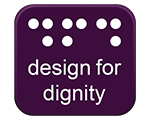Guidance on premises
Finding your store online
The journey to a store often begins when someone looks at products and services online. Websites can be more-or-less accessible for people with disability depending on how they are designed. People who are blind, have low vision or even dexterity restrictions still use the internet to investigate products and services, often using assistive technology that helps navigate and read a website. There are standards to help ensure that websites are accessible.*http://www.w3.org/
Viewed September 2016

Design focus
- Ask your developer or web host if your website is accessible according to global standards.
- Does your website tell people whether your store or stores are accessible? Can you search based on the accessibility features*See Barclays Bank http://ask.barclays.co.uk/branchfinder/
Viewed September 2016 of your store, such as:
- Automatic doors
- Accessible toilets
- Recharge points for mobility scooters and electric wheelchairs
- Flat and level entry
- Wheelchair access
- Level access
- Hearing loop
- Internal ramp
- External ramp
- Low height counter
- Accessible parking
- Can your contact centre staff and instore staff describe the accessibility of your sites?
- Is there any signage to indicate that it is accessible? This is a signal to people with disability that your competitors may not have put in place.




